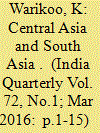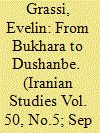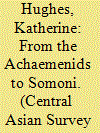| Srl | Item |
| 1 |
ID:
143350


|
|
|
|
|
| Summary/Abstract |
India and Central Asia have shared a geo-cultural affinity and a long tradition of historical contacts that dates back to antiquity. There is convergence of views and interests between the Central Asian Republics and India, on fundamental issues such as; (a) need to maintain social harmony and equilibrium by promoting inter-ethnic harmony and peaceful co-existence; (b) commitment to secularism and democracy and opposition to religious fundamentalism; (c) recognition of threat to regional security and stability from trans-border terrorism, arms and drug trafficking, religious extremism and ethnic-religious secessionism; (d) commitment to the principles of territorial integrity of nation states and inviolability of state borders; (e) promoting economic, scientific and cultural cooperation and (f) ensuring peaceful and tranquil neighbourhood in Afghanistan.
The Central Asian Republics, being cautious and wary of dominating influence of the powerful neighbours like Russia and China look towards India as a friend and partner, which does not have any political or territorial ambitions in the region. India is also expected to play a balancing role in the big power games in Central Asia.
|
|
|
|
|
|
|
|
|
|
|
|
|
|
|
|
| 2 |
ID:
154107


|
|
|
|
|
| Summary/Abstract |
This article offers an overview of Soviet Tajik Fiction under Stalinism (1920s–1950s) and during de-Stalinization (1950s–1970s) by contemplating the move from Bukhara to Dushanbe as a setting for Tajik stories and novels. In particular, it details the two main literary genres of the period, namely historical and psychological fiction. It argues that when tracing the main stages of evolution of Soviet Tajik fiction from the point of view of the setting one should mainly consider the works by Sadriddin Ayni, Jalol Ikromi and Fazliddin Muhammadiev.
|
|
|
|
|
|
|
|
|
|
|
|
|
|
|
|
| 3 |
ID:
156106


|
|
|
|
|
| Summary/Abstract |
This article focuses on the iconicity of contemporary Dushanbe’s capitol complex, with its state-sponsored architecture and memorial culture, part of the government of Tajikistan’s national identity construction. Dushanbe’s architecture post-independence is actant, a mnemonic and iconographical bridge between the present and favoured historical periods in a quest for national origins. A bricolage of historical symbols, including those of Achaemenid Iran and the early Islamic Samanids, is displayed here in a city with Soviet foundations. Together with pan-Iranian iconography is a desire by the government of Tajikistan for monumentality for its own sake. The capitol complex evokes the natural world, connected to a Central Asian conception of sacred space, suggesting an interlacing of power and religious authority. These monumental building projects are taking place against the backdrop of the destruction of Dushanbe’s ‘authentic’ Soviet architecture and built heritage in the capitol complex, itself a container for collective memory.
|
|
|
|
|
|
|
|
|
|
|
|
|
|
|
|